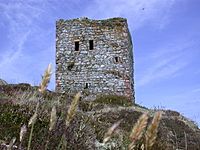Alexander Montgomerie facts for kids
Alexander Montgomerie (also known as Alasdair Mac Gumaraid in Scottish Gaelic) was a Scottish poet and courtier who lived from about 1550 to 1598. He was born in Ayrshire, a part of Scotland where both Scottish Gaelic and Scots were spoken.
Montgomerie was a key member of the Castalian Band. This was a group of poets at the court of King James VI in the 1580s. Even the King himself was part of this group! Montgomerie was one of the King's favorite poets for a while. He was a Catholic in a court that was mostly Protestant. This, along with some political problems, led to him being declared an outlaw in the mid-1590s.
His poems often explored themes of love. He also wrote sonnets about his own life. His style of poetry was quite new for his time. Some people even called him "Captain."
Contents
Early Life of Alexander Montgomerie

Alexander Montgomerie was a younger son of Hugh Montgomerie of Hessilhead. His family was related to the Earl of Eglinton and even distantly to King James VI.
We don't know much about his early life before 1580. It's believed he grew up in the Church of Scotland. He may have spent time in Argyll before traveling to Europe. Some say he became Catholic while in Spain. He might have also been a soldier in the Netherlands in the late 1570s, fighting for Scotland.
Montgomerie likely came to Edinburgh when King James's Catholic cousin, Esmé Stewart, arrived. Stewart's rise in the court matched the time when Montgomerie was most famous (1580–1586).
Alexander Montgomerie's Famous Works
Montgomerie's first known poems are The Navigation and Cartel of the Thre Ventrous Knichts. These were probably performed at court in 1580. The Navigatioun described a torchlit entrance at Holyrood Palace. It featured characters like a "Turk" and an "Egyptien."
Montgomerie became famous as the "master poet" of the Castalian Band. This happened after he won a funny poetry battle, called a flyting, against another poet named Patrick Hume of Polwarth. The King, who loved poetry, called Montgomerie his 'maister poete'.
Many of Montgomerie's poems were written in the early 1580s. These included sonnets and songs for the court. He also started his longest work, an allegorical poem called The Cherrie and the Slae. King James VI even included a part of this poem in his own book about writing poetry.
Life as a Courtier
On July 27, 1583, King James gave Montgomerie a pension. This was money from the income of Glasgow Cathedral. His career continued even after some political changes at court.
However, things changed around 1585 when the King took more control. In 1586, Montgomerie joined Scottish soldiers fighting for the Dutch Republic against Spain. He stayed there for over two years. He even served at Zutphen at the same time as the famous English poet Sir Philip Sidney. Montgomerie faced money problems because the Dutch didn't pay him. He made a deal in 1588 and returned to Scotland by the end of that year.
Life at court was different when he came back. His pension had been claimed by someone else while he was away. He fought a long legal battle to get it back but lost in 1593. This struggle led to some of his most powerful poems. He wrote angry sonnets to the judges, lawyers, and even the King. Despite this, he kept writing formal poems about court life.
Expulsion and Death
After losing his legal case, Montgomerie mostly disappeared from public view. In late 1596 or early 1597, he got involved in a Catholic plan. This plan was to take over Ailsa Craig, a rocky island, to help Spain support a rebellion in Ireland.
This plan, led by Montgomerie's friend Hugh Barclay, quickly failed. Barclay was killed. On July 14, 1597, Montgomerie was declared an outlaw. This meant he was outside the law.
He might have planned to leave Scotland, perhaps for a monastery in Germany. But he was still in Scotland when he died in August 1598. His death was controversial. The church in Edinburgh, Canongate Kirk, refused to bury him because he was Catholic. Only after the King stepped in did they change their minds. We don't know his exact burial spot, but it was likely in the church or grounds of Holyrood Abbey.
Alexander Montgomerie's Poetry
Most of Montgomerie's over 100 poems are found in one collection called the Ker manuscript. This collection was given to Edinburgh University Library by another poet, William Drummond of Hawthornden. It was probably put together soon after Montgomerie died.
His poems cover many topics. He wrote elegant court songs like Lyk as the dum Solsequium. He also wrote bitter, clever sonnets about his legal problems. Some poems were witty messages to the King. Others showed deep religious feelings, like A godly prayer.
Montgomerie is considered one of the best Middle Scots poets. He was perhaps the greatest Scottish writer of sonnets. His longest poem, The Cherrie and the Slae, is a religious allegory. It uses a special, musical stanza form, suggesting it was meant to be sung. His poetry connects to earlier Scottish poets like Henryson and Dunbar. He also translated works from French poets. His style can be compared to later writers like Donne.
Selected Early Books by Montgomerie
Here are the titles of some of the first books printed with Montgomerie's works:
- The Cherrie and the Slae. Composed into Scottis Meeter, be Alexander Mongomerie. Prented according to a Copie corrected be the Author himselfe. Printed in Edinburgh in 1597.
- The Mindes Melodie. Contayning certayne Psalmes of the Kinglie Propheete David, applyed to a new pleasant tune... Printed in Edinburgh in 1605.
- The Flyting betwixt Montgomery and Polwart. Printed in Edinburgh in 1629.
See Also
Images for kids






